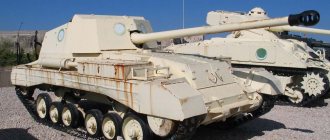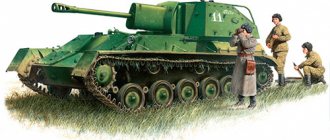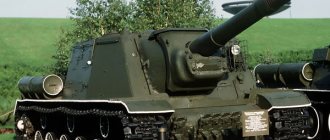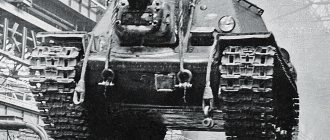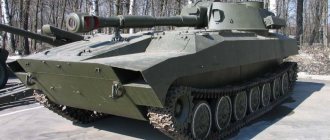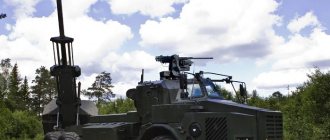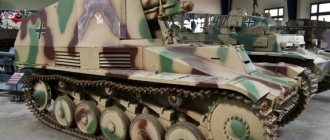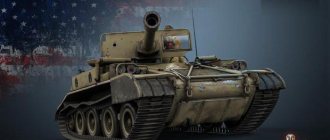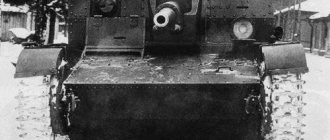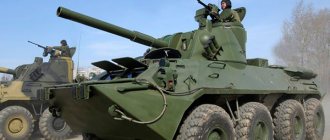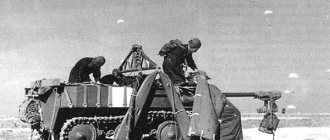Self-propelled gun SU-100 - self-propelled artillery unit of the Red Army
Structurally, the medium anti-tank self-propelled gun SU-100 was in many ways similar to the earlier SU-85. The main differences between these two vehicles concerned only the type of artillery system and related hull modifications. The SU-100 chassis, completely borrowed from the SU-85, included the following components (for one side): – five road wheels with a diameter of 830 mm with rubber tires and individual spring suspension; – front steering wheel, cast, with a crank mechanism for tensioning the tracks; – rear drive wheel with six rollers for engagement with the ridges of the track tracks; – the caterpillar consisted of 72 cast steel tracks with a width of 500 mm and a pitch of 172 mm (36 with a ridge and 36 without a ridge), the total mass of the caterpillar was 1150 kg.
Self-propelled gun SU-100 – video
Due to the increased mass, the thickness of the suspension springs was increased from 30 to 34 mm. Otherwise, the chassis elements did not undergo any changes and were completely interchangeable with T-34 tanks and SU-85 self-propelled guns. The body had a welded structure and was assembled from sheets of rolled armor steel. Structurally, it consisted of the bottom, bow and stern parts, sides, roof of the fighting compartment and roof of the engine-transmission compartment. Self-propelled gun armor was differentiated. The bow of the hull was wedge-shaped and was formed by two inclined armor plates. The top armor plate, 75 mm thick, was installed at an angle of 50°. In it, offset to the starboard side, a cutout was made for installing a gun; on the left there was a hatch closed by an armored cover with two viewing devices. The lower frontal armor plate had a thickness of 45 mm and was installed at an angle of 55°. Two towing hooks were welded to it. The sides and stern of the cabin also had a slight slope, but the thickness of the armor was limited to 45 mm. Landing handrails, brackets for external tanks and racks for fastening spare parts and accessories were also attached here. Along the sides there were fenders, ending with mud “wings”. Spare parts boxes were installed on the shelves, one on the left front and one on the back right. The roof of the fighting compartment was made of a single sheet of armor 20 mm thick, in which were mounted: a gun stopper cap, a double-leaf panorama hatch, a double-leaf landing hatch (L-shaped), a commander's cupola, an exhaust fan with a spherical armored cap. In the lower part of the body, made of armor plate 20 mm thick, there were holes for mounting brackets for road wheels, tension wheels and drive wheels. The final drive housing was welded to the rear part of the armor plate.
The engine and transmission compartment of the SU-100 was protected by an armor box consisting of two rear armor plates 45 mm thick, two inclined side armor plates and three upper armor plates. Although the thickness of the MTO side sheets was similar to the fighting compartment, their installation angle was increased. Cutouts were made in the upper side armor plates for longitudinal shutters and three hatches intended for access to the oil tank and the suspension shafts of the fourth and fifth rollers. On top, the side sheets were covered with convex armored caps with meshes for the passage of air to the blinds. The transmission compartment had a hinged convex sheet metal lid with five windows covered with mesh. The side gear housings, two towing hooks and two hinges of the upper hinged plate were mounted to the lower aft armor plate. The upper armor plate was folding and had a hatch with a lid in the center, and on the sides there were cutouts with armored caps for exhaust pipes. The bottom of the hull was “stacked” and assembled from four sheets of armor 20 mm thick, connected by welds with reinforced linings. An emergency hatch was made in the middle part of the bottom on the right (the lid opened down and to the right). The self-propelled gun was equipped with the same engine as its predecessors. The MTO was equipped with a 12-cylinder 4-stroke uncompressor diesel V-2-34 with a rated power of 450 hp. at 1700 rpm Operating power was 400 hp. at 1700 rpm, maximum – 500 hp. at 1800 rpm To clean the air entering the engine cylinders, a Multicyclone air cleaner was used. The engine could be started using an ST-700 electric starter with a power of 15 hp. or compressed air, for which there were two cylinders in the control compartment. Typically, DT diesel fuel was used for the V-2-34, but the use of gas oil grade “E” according to OST 8842 was also allowed. The main fuel supply was located in a 400-liter fuel tank located in the rear of the hull. Fuel was supplied to the engine using an NK-1 pump. 95-liter spare fuel tanks could be mounted on the sides of the MTO. The lubrication system was circulation and pressure from a three-section gear oil pump. The capacity of the oil tanks was 80 liters. The cooling system is liquid, closed, with forced circulation. On both sides of the engine, two tubular radiators with a capacity of 95 liters were mounted, tilted towards it.
The transmission of the SU-100 self-propelled gun did not differ from the tank one and consisted of a multi-disc main dry friction clutch, a manual 5-speed gearbox (with constant gear mesh), multi-disc side clutches, single-stage final drives and floating band brakes. The electrical equipment was made according to a single-drive circuit with a network voltage of 12 and 24 V. It included a GT-4563A generator with a power of 1 kW and four 6-STE-128 batteries with a capacity of 128 Ah each. Consumers of electrical energy included an ST-700 starter with a starting relay for starting the engine, two MV-12 fan motors that provided ventilation for the fighting compartment, external and internal lighting devices, a VG-4 signal for external sound signaling, an electric trigger for the gun firing mechanism, a heater for the protective glass of the sight, an electric igniter for smoke bombs, a radio station and an internal intercom, telephone communication devices between crew members. The SU-100 of early production was equipped with a short-wave transceiver simplex radio station 9-RS or 9-RM, which provided communication at a distance of up to 25 km. For communication between crew members, an internal intercom TPU-3-bis-F was used. The armament of the SU-100 consisted of a 100-mm D-10S cannon, model 1944, with a barrel length of 56 calibers. The total weight was 1435 kg. The gun had horizontal guidance angles ranging from 16° and vertical guidance from -3° to +20°. The maximum recoil length when fired did not exceed 570 mm. The main trigger mechanism was electric, but there was also a mechanical manual one. Complete with the D-10S gun, a telescopic articulated sight TSh-19 was installed (for direct fire), as well as a side level and a panorama (for shooting from closed positions). The practical rate of fire of the gun is 5-6 rounds per minute. The gun was mounted in a cutout of the frontal armor plate and protected by fixed armor of a complex shape, which was bolted to the hull. Externally, the gun installation is protected by a movable armored spherical mask.
The gun's ammunition consisted of 33 rounds placed on racks in the rear (8) and on the left side (17) of the fighting compartment, as well as on the floor on the right (8). The range of ammunition for the D-10S turned out to be very wide, especially closer to the end of the war. It included six types of shots: UBR-412 - a unitary cartridge with an armor-piercing tracer sharp-headed projectile BR-412 and an MD-8 fuse UBR-412B - a unitary cartridge with an armor-piercing tracer blunt-headed projectile BR-412B and an MD-8 UO- fuse 412 – unitary cartridge with a naval fragmentation grenade O-412 and an RGM fuse UOF-412 – unitary cartridge with a high-explosive fragmentation grenade OF-412 and an RGM fuse UOF-412U – unitary cartridge with a high-explosive fragmentation grenade OF-412 with a reduced charge and fuse RGM UD-412 - unitary smoke shot weighing 30.1 kg with fuses RGM, RGM-6, V-429 UD-412U - unitary smoke shot weighing 30.1 kg with fuse V-429 UBR-421D - unitary cartridge with armor-piercing tracer projectile with a ballistic armor-piercing tip BR-412D UBK9 - unitary cartridge with a cumulative projectile BK5M Unitary cartridge with an armor-piercing sub-caliber projectile. The last three types of shells appeared in the SU-100 ammunition load only after the end of the war, so that after 1945 the standard equipment included 16 high-explosive fragmentation, 10 armor-piercing and 7 cumulative rounds. Thus, the SU-100 self-propelled gun was more of a multifunctional assault weapon than a specialized anti-tank weapon. Additionally, two 7.62-mm PPSh submachine guns with 1,420 rounds of ammunition (20 discs), 4 anti-tank grenades and 24 F-1 hand grenades were stowed in the fighting compartment. To set up a smoke screen on the battlefield, two MDS smoke bombs were installed at the rear of the vehicle, which were ignited by the loader by turning on two toggle switches on the MDS panel mounted on the engine bulkhead.
Surveillance devices were few in number, but very well placed on the body of the self-propelled gun. The driver in the stowed position drove the car with the hatch open, and in the combat position he used optical viewing devices with armored covers. The commander's cupola, located on the starboard side, had five observation targets with armored glass. An MK-4 surveillance device was mounted on the roof. The standard paint for the SU-100 was protective green on all surfaces. Three-digit numbers and a unit identification mark were painted in white paint on the sides of the conning tower. In winter, self-propelled guns were painted with easily washable white paint. Sometimes marks could be placed on the roof and sides of the cabin for identification from the air. These could be circles and stripes, but in one of the cases white crosses were used. Inscriptions and slogans were allowed on the sides, for example: “Soviet Prospector”, “For the Motherland”, etc.
Combat use of the Su-100 self-propelled guns in Hungary
The first important battle in the long combat path of the SU-100 was the operation to destroy enemy troops in the Budapest area. In the late autumn of 1944, Soviet troops managed to blockade the city, but the German-Hungarian group located in the “ring” was very strong. It was necessary to transfer reserves - in December, the 1st Guards Tank Corps of I.N. Russiyanov arrived at the disposal of the command of the 3rd Ukrainian Front. It is curious that this unit was created from the remnants of units of the 100th Infantry Division (!), which actually defended Minsk alone three years earlier. During this time, the corps departed several times for reorganization and, before being sent to Hungary, received a very motley composition. Russiyanov’s unit received both relatively new T-34s and “worn” M4A2 “Sherman” transferred from other units. To strengthen the corps, three self-propelled artillery regiments equipped with 59 of the latest SU-100s were immediately introduced into its composition. Having unloaded on the eastern bank of the Danube, the command instructed the self-propelled guns to conduct an offensive in the Bichke area before the enemy managed to gain a foothold there. During January 4, the crews of three SU-100 regiments and infantry units outflanked the German 93rd Infantry Division and rushed behind enemy lines. The settlement was occupied by Soviet troops, who went on the defensive in anticipation of a counterattack. Since its direction remained unknown, the forces of the regiments were greatly stretched along the front. By the morning of January 6, two SU-100 regiments were transferred to the operational subordination of the 18th Tank Tank, which had been badly damaged in recent battles near the village of Bayna. The baptism of fire of the “hundreds” took place on January 7 near Zhambek. On this day, the Germans managed to push through the defenses of the 49th Infantry Division, whose formations began to retreat. Left alone with the enemy, the crews of the 382nd SUP were forced to fight back with all available means. The German offensive was stopped at great cost - 9 self-propelled guns were destroyed and 2 more self-propelled guns were knocked out. However, the most fierce battle, which resulted in an oncoming tank battle, broke out on January 9 near Zamol. Having received the order to counterattack the enemy, units of the 1st Guards. The brigade ran into strong anti-tank defenses. Around noon, in the Gyula area, the Germans brought significant tanks into the battle, which led to heavy mutual losses - during that day the brigade lost 18 tanks (mostly Sherman) and more than 600 personnel. Next, the 382nd regiment was transferred to the subordination of the 21st Infantry Division and took part in the defense of Szekesfehervár, and the self-propelled guns of the 1st Guards Brigade, consisting of two batteries, were sent to Barachka and Felshe-Belshe. It was here that the guards were attacked by tank formations of the SS Viking and Totenkompf divisions. The SU-100 had a more than worthy opponent - in addition to various StuG and Pz.IV, the Germans brought heavy tanks Pz.VI “Tiger” and Pz.VI “Konigtiger” into battle. The enemy managed to drive a “wedge” into the formations of two cavalry divisions, which had practically no tanks, and made their way to Barachka. On the morning of January 24, the Wehrmacht launched a general offensive with the participation of three tank divisions of the IV Corps at once, but it was not successful and the attack fizzled out.
In total, from January 19 to January 25 (during Operation Conrad II), the 1st Guards Mechanized Corps lost 54 “Americans” and 17 SU-100s. The beginning for the “hundreds” did not seem to look very rosy, but we must not forget that in a number of cases self-propelled guns were used as assault weapons and operated without the support of infantry and tanks. Due to the aggravation of the situation, the front command on January 25 brought the last reserves into the battle, including the 145th SUP equipped with the SU-100. The front was stabilized by January 30, after which the defeat of the remaining enemy forces began. The assault on Budapest ended on February 15, when the remnants of the IX SS Mountain Corps made a breakthrough and were even able to achieve some successes. True, out of 28,000 German and Hungarian soldiers, about 800 managed to break through to their own. However, the battle on Hungarian soil did not end there. To defeat the remaining German-Hungarian forces, the Soviet command planned an operation on Lake Balaton. Although the armored forces of the Red Army also suffered heavy losses, their strike potential was still strong. During the Balaton operation, the 207th, 208th and 209th self-propelled artillery brigades, which had previously been in reserve, distinguished themselves. By March 10, the total number of SU-100s was already 188 vehicles minus losses. The defensive battle developed successfully for the Soviet troops, but both sides suffered significant losses. The command of the 28th Army was forced to transfer the 208th Brigade to the front edge of the front, transferring it to the subordination of the 135th Rifle Corps, but this measure was clearly too late. The self-propelled guns were ordered to move forward in the morning of March 9 in two regiments to the Nagyherczek - Deg area, and the third regiment was left in the army reserve in the Szar area. There was practically no preparation for the march, so on the Tsetse-Szekesfehervár highway the 1068th Regiment came under attack from breaking German tanks and lost 14 out of 21 self-propelled guns. Another regiment fighting in Slovakia found itself in a similar situation months later. A post-war photograph with three burnt-out SU-100s on the road near Brno is now widely known. All self-propelled guns were hit by fire from a single German anti-tank self-propelled gun firing from an ambush. This once again proved that even a defeated enemy should not be discounted and it was worth conducting reconnaissance before the march. On the other hand, the armor of the SU-100 clearly could not withstand fire from 75 mm and 88 mm anti-tank guns. It was not possible to make up for this loss then. In total, on March 8-9, the 208th brigade knocked out and destroyed 14 enemy tanks and self-propelled guns, as well as 33 armored personnel carriers. Our own combat losses amounted to 12 self-propelled guns, 8 of which burned out. During March 10, repelling a counterattack of enemy forces, the crews of the 1951st and 1953rd regiments inflicted significant damage on it. Thus, the SU-100 under the battery commander, senior lieutenant A. Kocherga, as well as the combat vehicles of junior lieutenants Vorozhbitsky and Samarin, each knocked out and burned three German tanks and self-propelled guns. On another section of the front, a battery of the 1952nd regiment under the command of Captain Vasiliev knocked out three “royal tigers” without suffering any losses of their own. On the same day, the 1953rd Regiment was transferred to the 5th Cavalry Corps and was given the task of organizing an ambush and destroying German troops trying to break out of the encirclement in the Simontornia area. Having camouflaged their vehicles in the forest through which the Germans were preparing to attack, the crews organized hidden firing positions. On the morning of March 11, 14 German tanks, including heavy ones, went on the attack. At the signal, the self-propelled guns entered their positions and opened fire from a distance of 1,500 meters. Despite the great distance, the Germans immediately lost three tanks and were forced to stop the attack.
The actions of the self-propelled gun crews deserved the highest praise, however, due to the large losses in tanks, which reached 50-70% by the end of the Balaton operation, during March 11-12, SU-100 batteries were used for a purpose unusual for them - direct infantry support. The result was quite expected and led to the loss of several dozen vehicles, most of which could not be restored. Suffice it to say that in the 208th sabr, as of March 5, there were 63 “hundreds”, but by March 16 their number had decreased to 23. The main result of the battle in Hungary was the consolidation of the practice of ambushes, the implementation of which began back in 1944 with using SU-85. As a rule, the “hundredth” battery was camouflaged in the forest or on the reverse slopes of the mountains, and the firing positions were set up 100-200 meters in front. An observation post was set up nearby, manned by an officer and the commander’s SU-76 and T-34. When the enemy appeared, the self-propelled guns fired several shots and went to cover, preventing the enemy from detecting themselves. If panic arose among the attackers, the “execution” continued. Typically, the SU-100 opened fire from a distance of 1000-1300 meters, and shells fired from the D-10S cannon often covered the target the first time. For medium tanks of the Pz.IV type, this ended in partial destruction of the hull, and large holes appeared in the armor of the Panthers and Tigers. The report on combat operations in defensive battles near Budapest noted that the SU-100 self-propelled guns, with slightly larger dimensions, have a significant advantage over the SU-85 in terms of firepower. Although the rate of fire of the D-10S in combat conditions was 3-4 rounds per minute (5-6 for the D-5S-85 cannon), the mass of the shot noticeably compensated for this lag. It was also noted that “the frontal part of the SU-100 is invulnerable for light and medium artillery; for heavy tanks and 88-mm artillery, the frontal armor is insufficient and very fragile.” Among the shortcomings, complaints were made about the tight operation of the gun guidance mechanisms and the greater vulnerability of the sighting devices. In addition, there was a desire to equip the SU-100 with machine guns, as was done on the heavy ISU-152. The final conclusion stated that 100-mm self-propelled guns are “the most effective means of combating enemy heavy tanks.”
Performance characteristics of the Su-100 self-propelled gun
| Crew, people | 4 |
| Combat weight, t | 31,6 |
| Length, m | 9,45 |
| Width, m | 3 |
| Height, m | 2,24 |
| Armament | 100 mm D-10S gun |
| Ammunition | 33 shots |
| Engine | V-2-34M with a power of 520 hp. |
| Maximum speed, km/h | 50 |
| Cruising range, km | 310 |
| Booking | gun mask – 110 mm front of the cabin – 75 mm front of the hull – 45 mm side of the hull – 45 mm rear of the hull – 40 mm bottom – 15 mm roof – 20 mm |
| Aiming devices | telescopic sight 10T-15 panoramic sight |
| Means of communication | radio station 9-RS, intercom TPU-3F-bis, tank phone |
Photo of SAU Su-100 of the Syrian army destroyed by the Israeli Air Force
Egyptian self-propelled gun Su-100 captured by the British
Self-propelled gun Su-100 of the Algerian army
Source
Equipment
The SU-100 has a powerful gun, a low silhouette and good dynamics, but it pays for this with low accuracy and a long reload time. Considering all the pros and cons of PT, the following equipment should be installed:
- Large caliber rammer. The main equipment for the Soviet tank destroyer, as it significantly reduces reload time.
- Camouflage network. Significantly improves the camouflage coefficient.
- Stereoscopic telescope. Increases maximum viewing radius.
A camouflage net with a stereo tube only works in a standing position, so for this equipment to work, you must stand in ambush without moving.
As an alternative, you can install reinforced aiming drives instead of a stereo tube . In this case, the SU-100 will become more accurate at shooting at long distances, but the viewing radius will not allow it to detect the enemy at medium distances.
GAZ-15-126 (SU-76M, SU-15)
SU-76M
Nevertheless, the experience of creating the GAZ-71 was useful to the Gorky people. In 1943, the GAZ Design Bureau was tasked with modernizing the unsuccessful SU-76 self-propelled gun developed at the Kirov plant No. 38.
Leading designer Vladimir Alekseevich Dedkov seriously reconfigured the vehicle and used the GAZ-203 power plant from the T-70 tank. It was a tandem of two GAZ-202 engines paired in series. This solution made it possible to significantly increase the reliability of the power plant. The chassis was almost completely similar to the T-70 tank, except that it was lengthened by one roller.
In general, the SU-76M turned out to be a compromise, with many advantages and disadvantages. The military praised the vehicle for its excellent maneuverability and light weight. The self-propelled gun could easily overcome off-road conditions inaccessible to heavier equipment. On the other hand, the low weight of the vehicle was due to its weak bulletproof armor. Be that as it may, the SU-76M (SU-15) was successfully produced at GAZ until 1945. In total, the plant produced 9133 self-propelled guns.
GAZ-71 (SU-71), GAZ-72 (SU-72)
GAZ-71
In 1942, the Main Armored Directorate (GABTU) turned to the Gorky Automobile Plant with a request to create a light artillery mount with a 76-mm cannon. GAZ already had experience in producing and modernizing light tanks T-60 and T-70, so it did not refuse to work.
In the fall of 1942, three experimental self-propelled guns GAZ-71 (designer V.A. Solovyov) and one self-propelled anti-aircraft gun GAZ-72 (designer A.S. Maklakov) were built. Both vehicles were based on a lengthened and thoroughly modified T-70 tank chassis. The rear sprockets were driven by a twin power unit of two GAZ-202 engines with a total power of 140 hp. The main armament of the GAZ-71 was the 76-mm ZIS-3 cannon, and the GAZ-72 was equipped with a 37-mm 61-K anti-aircraft gun.
The vehicles were not put into production due to low reliability and unsatisfactory combat effectiveness.
Crew Perks
Commander
- The Brotherhood of War
- Sixth Sense
- Disguise
Gunner
- The Brotherhood of War
- Disguise
- Sniper
Driver mechanic
- The Brotherhood of War
- Disguise
- Virtuoso
Charging
- The Brotherhood of War
- Disguise
- Desperate
I advise you to upgrade your combat fraternity as your first skill - you will do it quite quickly, and the skill itself is useful for any technique. Next, we’ll upgrade camouflage (it will make us even more invisible) for everyone, and for the commander – a sixth sense. The third skill we take is a sniper for the gunner - we will have a very good profit, since our gun is very fast-firing. The Virtuoso will enhance the already good reversal rate, and the Desperate will help in “fights to the death.”
Vulnerabilities of the machine
The location of the modules and crew is shown below:
Orange - commander, gunner, loader Red - engine, tanks, transmission Green - easily penetrated areas White - ammunition rack Blue - driver.
